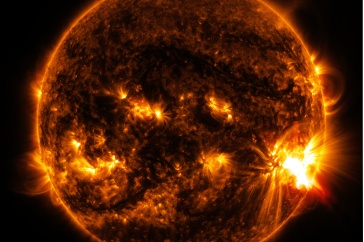
Graphic by NASA.
UNH researchers have received a $1.62 million grant from the National Science Foundation to study ultra-low frequency magnetic waves from space. This research will help scientists better understand Earth's radiation belts, which are an important component in the space weather that can impact our power grid and other technologies.
"This grant will help support our research in making global measurements of Earth's magnetic field and, specifically, ultra-low frequency waves," said Marc Lessard, professor of physics in UNH's Space Science Center and the College of Engineering and Physical Sciences. "These waves are thought to play an important role in Earth's radiation belts and magnetospheric substorms. These goals are important in trying to understand the effects of magnetic storms, or space weather, that can interfere with communication satellites, GPS and so-called ground-induced currents that affect our power grid."

The five-year project will rely on an array of induction coil magnetometers that measure ultra-low frequency waves in Earth's magnetic field. The magnetometers will be installed underground in the Arctic regions of northern Canada, Greenland and Svalbard, Norway. Data collected from this project will help support UNH’s research to improve our understanding of magnetic storms, or space weather, that can affect technology.
Lessard says the project has a significant student training component: The funding will support a UNH graduate student for the entire five years of the project, and a UNH postdoctoral researchers for the first three years. Two UNH undergraduates have already begun to fabricate the magnetometers for the project. Lessard says his team will also purchase the magnetic material from Mushield, Inc., a company based in Manchester, New Hampshire.
This type of hands-on research experience not only results in real-world data, but it also provides an amazing opportunity for the students: From fabricating and testing the magnetometers to holding team meetings and checking the deployment schedules, the students working on this mission will emerge with valuable research project management skills to help launch their careers.
"This project is another example of very compelling, state-of-the-art science where undergraduates and graduate students are taking on the role of research scientists," Lessard says. "It continues a decades-long series of student opportunities supported by UNH, and we're proud to continue to be a part of it."
The Institute for the Study of Earth, Oceans, and Space (EOS) is UNH's largest research enterprise, comprising six centers with a focus on interdisciplinary, high-impact research on Earth and climate systems, space science, the marine environment, seafloor mapping and environmental acoustics. With more than $60 million in external funding secured annually, EOS fosters an intellectual and scientific environment that advances visionary scholarship and leadership in world-class research and graduate education.
-
Written By:
Rebecca Irelan | Institute for the Study of Earth, Oceans, and Space | rebecca.irelan@unh.edu | 603-862-0990
















































